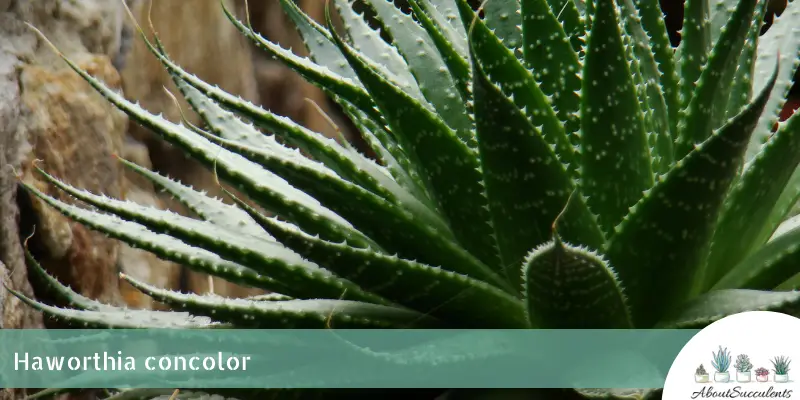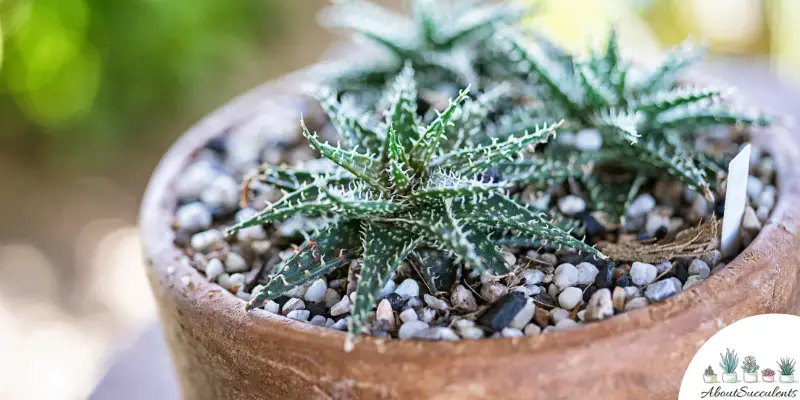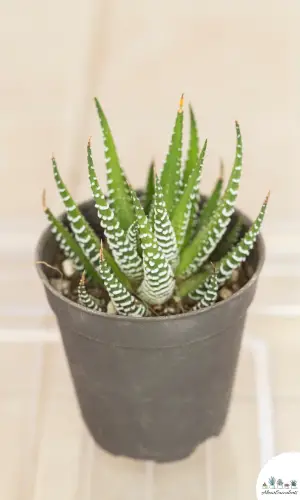
Haworthia Concolor easily wins over the hearts and minds of horticulturists with its pointy, lime green, and fleshy leaves that are adorably accented with white dots.
Also known as Concolor Zebra Plant, this succulent species is native to South Africa and is a member of the Asphodelaceae family.
Concolor Zebra Plant is a small, slow-growing type of succulent. At maturity, this plant only reaches a height of 15cm (6”).
In the summertime, Haworthia Concolor produces small white flowers that appear on the edge of the peduncles and are grouped into clusters.
General Information:
Also known as: Concolor Zebra Plant
Plant Family: Asphodelaceae
Origin: Native to South Africa.
Height: 15cm (6”)
Exposure: Partial sunlight for up to 6 hours.
Water Needs: Typical succulent watering needs which means to water only when the soil is absolutely dry.
Soil Type: Cactus mix with perlite, pumice, or coarse sand for better drainage.
Soil pH: 5.0 to 7.0
How to Grow and Care for Haworthia Concolor

Haworthia Concolor is the ideal succulent plant for beginners to start out with because it’s very easy to grow and care for.
If you’re a busy person, you’ll still have time to care for Concolor Zebra Plant because it won’t require too much of your day.
One thing you have to remember is that this is a type of succulent plant that’s not cold-hardy. It would be best to keep Haworthia in a pot that can be moved inside your home if temperatures drop below -1.1° C (30° F).
Sunlight
Haworthia Concolor grows better with partial sunlight. In your outdoor garden, place the succulent in a location where it can get up to 6 hours of morning or late afternoon sun.
As a houseplant, place the pot near a window that receives 4 to 6 hours of partial sunlight. If this is a problem, buy a Grow Light so that Zebra Plant Haworthia can still get its daily dose of light.
Watering

Haworthia Concolor will thrive with fewer watering schedules. Don’t water the soil unless it’s 100% dry. Depending on the season, you might only have to water this succulent every seven to 10 days.
In the summer months, the soil will dry out faster compared to winter. You should expect to water the soil more during the hot and dry months.
Another important thing to keep in mind is to water the soil and never the plant. The soil should be given a thorough drenching. You’ll know that the soil has had enough water when you see it coming out of the drain holes.
Watering the plant will keep it in a moistened condition much longer than necessary and will put it at risk of developing root rot.
Pot and Soil
Choose a pot that has good drainage qualities. The best material for your pot is either ceramic or terracotta. These types of pot support the proper evaporation of water from the soil.
You must also buy a pot that has adequate drain holes at the bottom to allow excess water to come out of the soil.
Haworthia Concolor can grow in almost every type of soil but show your love by planting it in fresh cactus mix. Include ingredients such as perlite, pumice, and coarse sand to improve its drainage.
How to Propagate Haworthia Concolor
Horticulturists love Haworthia Concolor for one other reason – the succulent makes it easy for you to propagate by gifting you with offsets.
You can also grow Zebra Plant Haworthia from seeds but it will be more difficult.
Method 1 – Offsets
Step 1: Gently pull out the offsets growing at the base of the main plant. You can also cut them off with a sterilized knife.
Step 2: Allow the offsets 2 to 3 days to dry out and develop calluses.
Step 3: Plant the offsets in a cactus mix. Lightly water the soil until the roots take hold.
Step 4: Once the roots are firmly in the soil, give Haworthia Concolor water only when the soil is dry.
Method 2 – Seeds
Step 1: Plant the seeds in a cactus mix.
Step 2: Lightly water the soil.
Step 3: Cover the soil with plastic wrap.
Step 4: Place the pot near a window that receives partial sunlight.
Step 5: When the roots have sprouted, remove the plastic wrap.
Step 6: Water the soil only when it’s completely dry.
Is Haworthia Concolor Toxic to Cats and Dogs?
Haworthia Concolor is not listed on the website of the American Society for the Prevention of Cruelty to Animals (ASPCA) as a plant that’s toxic to cats and dogs.
Why Is My Haworthia Concolor Dying?
Overwatering is the leading cause of death of Haworthia Concolor. It’s also possible that your succulent plant has gotten weaker because pests have drained it of sap.
All is not lost. Follow our tips below and save Zebra Plant Concolor while there’s time.
Overwatering
When it comes to watering, neglect is best for succulents. Giving Haworthia Concolor water while its soil is still moist will cause its roots to rot. The rotten roots will develop a fungal infection that will spread throughout the plant.
You know if a fungal infection is taking place when you see discoloration on parts of the plant. The infection has made its way from the roots to inside Concolor Zebra Plant and is on its way out.
Cut off all the discolored parts of Haworthia with a sterilized pair of garden shears. Since the fungi might contaminate the shears, wipe them with 70% isopropyl alcohol after every cut.
Remove Concolor Zebra Plant from its pot and shake off the excess soil. Cut off all the rotten roots and let the plant dry out before repotting it.
Fill a new ceramic or terracotta pot with fresh cactus mix and replant Haworthia Concolor.
Pest Infestation
Mealybugs love to drink the sap of Haworthia Concolor. While it’s drinking away the sap, these pests will leave white, cotton-like substances on your plant that might cause a fungal infection.
Keep mealybugs away by spraying the succulent with neem oil or any organic insecticide. Remove the white substances by wiping them away with a cotton ball soaked in 70% isopropyl alcohol.
Does Haworthia Concolor Produce Flowers?
Yes, Haworthia Concolor produces small white flowers that appear in clusters during the summer.
Frequently Asked Questions
Last Updated on June 9, 2022 by Sofia Lara